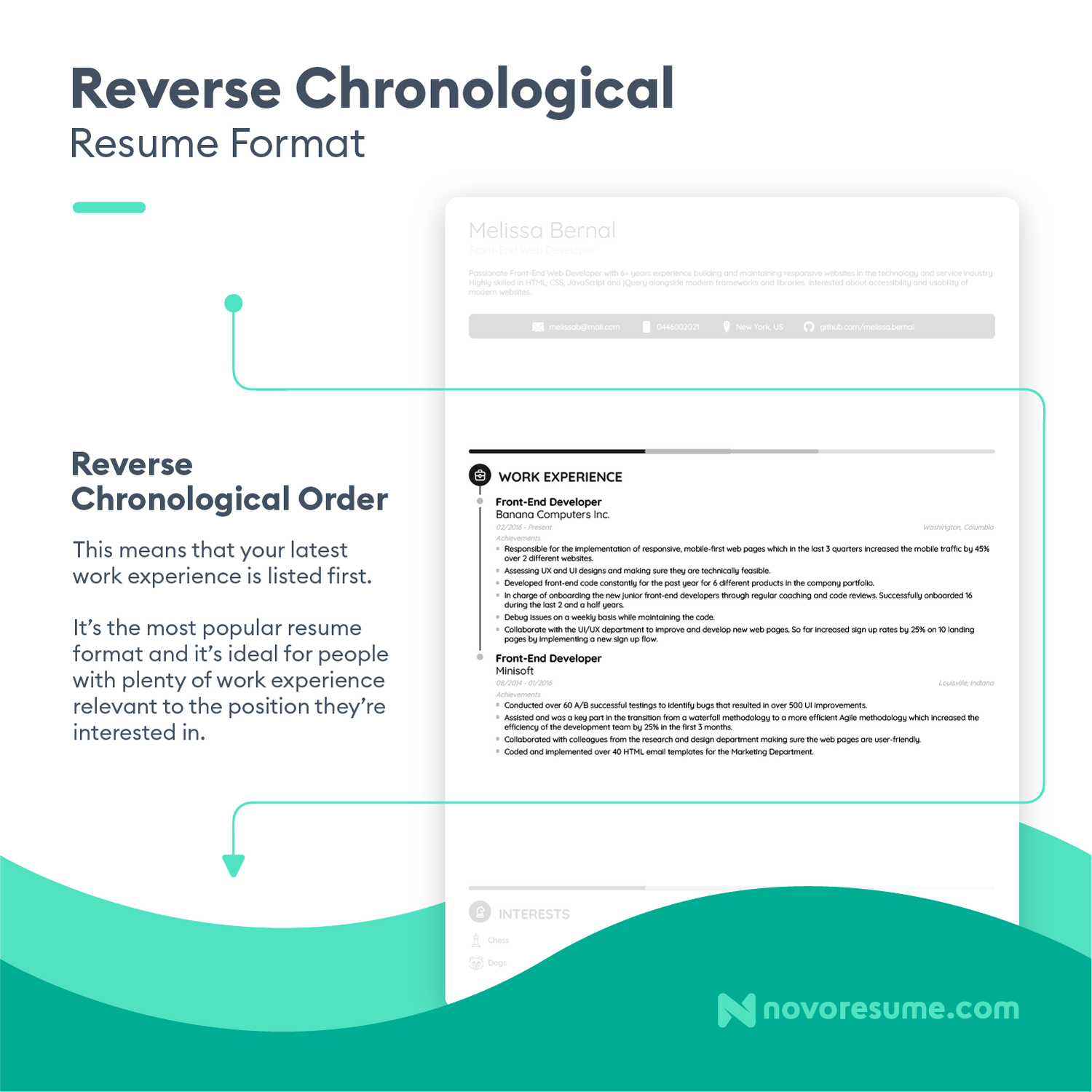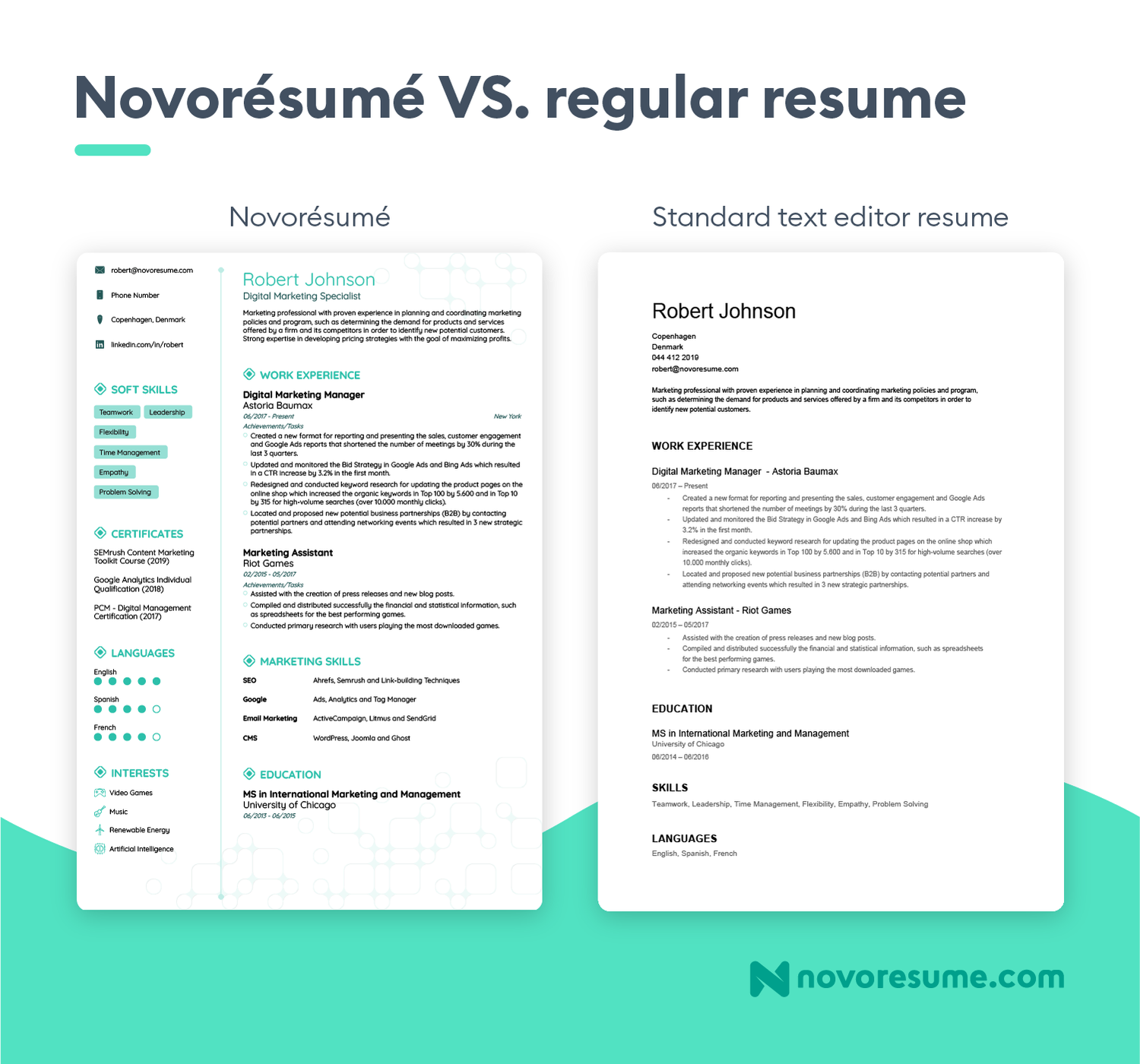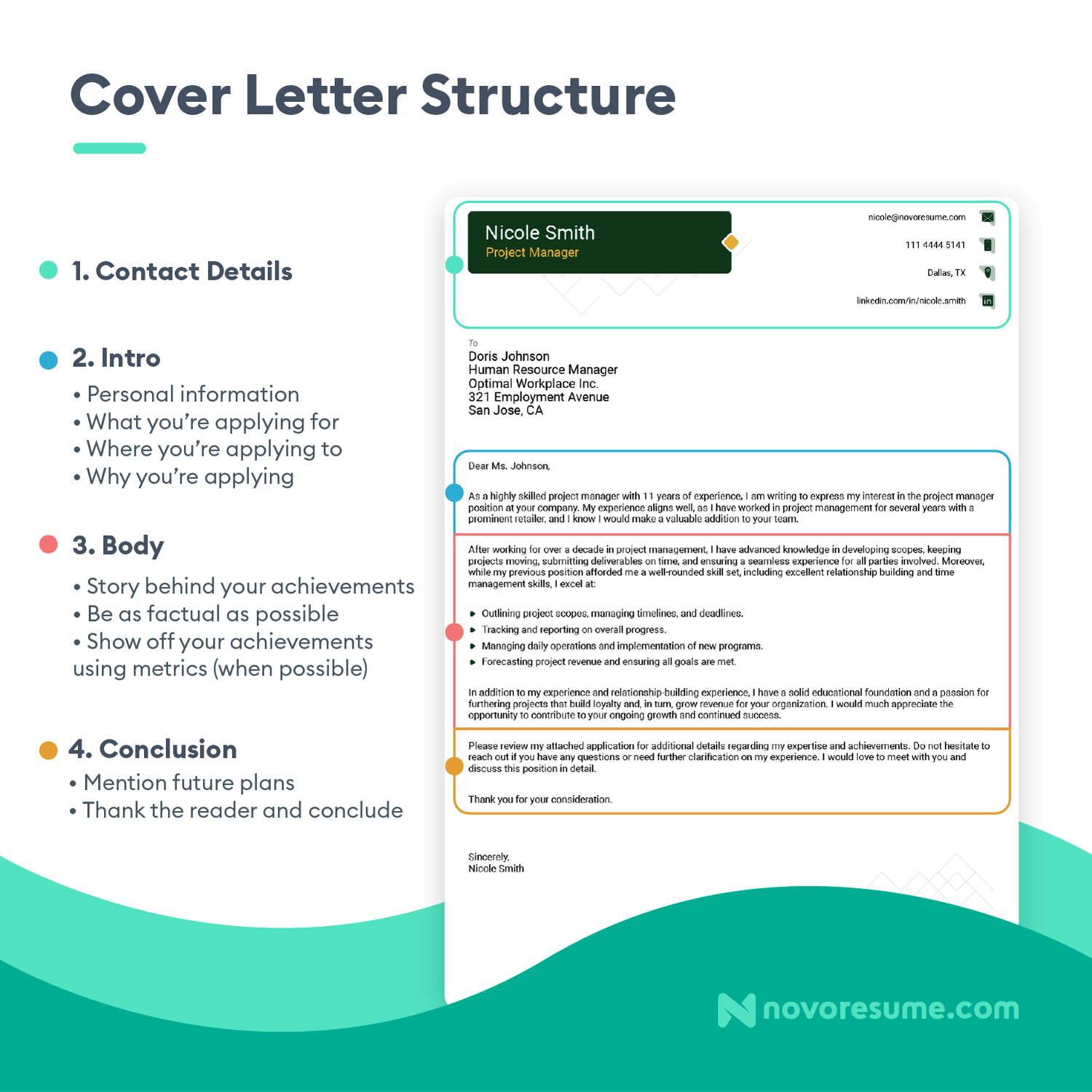You grew up with some of the best cartoons and video games out there.
Now, you want nothing more than to work on the next generation of animations yourself.
But as exciting as stepping into the world of animation is, it can be just as daunting if your resume doesn’t capture the full extent of your creativity.
It’s not uncommon to find yourself staring at a blank page, trying to convey your ambition and know-how to no avail.
But there’s no need to worry.
In this article, we’re going to help you set your career in motion.
We’re going to cover:
- What a Great Animator Resume Example Looks Like
- 9 Steps to Write the Perfect Animator Resume
- What to Include in Your Animator Resume
…and more!
Let’s get started.
Animator Resume Example

Now that is one great animator resume example.
Here’s just what it gets right:
- Reverse-chronological format. Choosing this format puts the spotlight on your most recent work experience and achievements, so it’s no wonder it’s hiring managers’ favorite worldwide.
- Relevant contact details. This animator resume example only includes relevant contact information, such as the candidate’s full name, professional email address, phone number, location, and links to professional websites and social media.
- Eye-catching resume summary. A resume summary that highlights the candidate’s skills and top achievements in the header guarantees to grab the hiring manager’s attention from the get-go.
- Achievements over responsibilities. The animator resume example above focuses on achievements over day-to-day responsibilities and uses numbers whenever possible to back up their claims with facts and data.
- Bullet points. Avoiding paragraphs and blocks of text is a good rule of thumb when writing your resume. The animator resume example above uses bullet points to keep their resume organized and reader-friendly.
- Tailored skills. As skilled as the candidate may be, their animator resume only focuses on in-demand 3D animation skills and soft skills listed in the job ad.
- Brief education section. Work experience as an animator and an updated portfolio matter more than formal education, so this animator's resume example keeps their education section short and to the point.
- Optional sections. The animator resume example above uses optional sections to highlight the candidate’s other abilities and qualifications that make them a great choice for the job.
9 Steps for the Perfect Animator Resume
You’ve seen what a job-winning animator resume looks like, so now it’s time to write one yourself.
Let’s break down the process of making the perfect animator resume, step-by-step:
#1. Pick the right format
Before you can fill in the contents of your resume, you’ll need to pick a format.
Generally, there are three resume formats you can choose from:
- Reverse-chronological (also known as chronological)
- Functional (also known as skill-based)
- Combination (a mix of the chronological and functional formats)
In 99% of cases, we recommend that you choose the reverse-chronological resume format for your animator resume.
The reverse chronological format is the most popular of all three, and it’s what hiring managers actually expect, so that makes it the best choice.
It effectively highlights your most recent work experience and accomplishments first, making it the perfect choice to show off your strengths.
Here’s an example of the reverse-chronological resume format:

Now that you know how to format your resume, it’s time to talk about your resume layout.
Before the hiring manager reads your resume, they’ll look at it. And if the first impression it makes is of a messy, cluttered document, they might skip reading it altogether.
Let’s look at some basic resume layout tips you should follow to avoid this from happening:
- Set the right margins. You want your resume to look well-organized, not cluttered or empty. Start by setting the margins to one inch on all sides of the page.
- Line spacing. Stick to the standard line spacing, which is 1.0 between text and 1.15 between double lines and after subheadings.
- Use a professional font. There are great resume fonts out there, so forget about Comic Sans or Times New Roman. Choose something professional and easy to read, but not overly used. (E.g. Roboto, Ubuntu, etc.)
- Keep it to one page. Hiring managers go through hundreds of resumes daily, so you have to keep yours short and attention-grabbing. One page is more than enough, for a resume, unless you have tons of relevant work experience.
- Save it to the right file format. Always save your resume as a PDF file, unless the employer specifically requests otherwise. As a PDF, you ensure your resume’s layout stays the same across any device and OS the hiring manager uses to open it.
Or Use a Resume Template to Save Time
Creating your animator resume from scratch is a lot of work.
Tweaking the layout, adjusting the margins, and trying out different font sizes just to fit everything on one page can turn into a challenge.
Wanna skip all the hassle?
Just try any of our free, tried-and-tested resume templates.
Each template is designed in collaboration with HR professionals to make sure your resume is easy to read, ATS-friendly, modern, and professional.
See for yourself how one of our templates looks compared to a basic black-and-white traditional template:

#2. List Your Contact Information
As creative as you might be, the contact information section is no place for avant-garde decisions.
On the contrary, your contact information section needs to be factually correct and professional. You won’t be getting any interview calls if you missed a typo in your phone number.
Here’s what you should include:
- Full Name. (E.g. John Smith).
- Professional Title. Make sure this matches the job title you’re applying for. (e.g. 2D Computer Game Animator)
- Phone Number. Include your phone number’s dial code, especially if you’re applying for a job abroad.
- Email Address. Always use a professional email address with some variation of your first and last name, not something with nicknames or clever jokes. (e.g. johnsmith@gmail.com, not herecomesjohnny@hotmail.com)
- Portfolio Link. A link to your Behance profile or other platforms you use to showcase your best work, such as a personal portfolio website.
- Location. If you’re looking for a remote position or are willing to relocate abroad, mention it on your resume.
Simon Smith - 3D Animator
+45 7459 3679 - simon.smith@gmail.com
www.SimonsMadeUpArtWebsite.com
Arhus, Denmark
Simmy Smith - 3D Motion Master
07 459 3679 - simmydoestheshimmy@hotmail.com
Vikingland
#3. Write a Resume Summary or Objective
Your resume’s header should contain a short paragraph aimed to capture the hiring manager’s attention within three to four sentences.
Think of that paragraph as a trailer for the rest of your resume. The more captivating it is, the better chance you have of piquing a hiring manager’s interest.
You have two options on how to approach this:
- Resume summary. A resume summary is a quick introduction to your professional experiences and achievements. We recommend this for animators who already have some work experience.
- Resume objective. A resume objective is an overview of your career goals and aspirations. We recommend that animators with no work experience stick to this one.
So what do they look like in practice?
Let’s look at a resume summary first.
- Creative game animator with a strong background in VFX, looking to join the team at Studio X. 6+ years of experience in 3D modeling, rigging, skeletal animation, and rendering. Passionate about working with a studio that involves creating complex animations to tell meaningful stories. Skilled in Autodesk Maya, Blender, and Adobe Creative Suite.
That’s a great introduction, and it tells the hiring manager exactly why they should read through the rest of the candidate’s resume.
And what about the resume objective?
- Dedicated animation student looking for a career start at Gaming Company X. Passionate about telling stories through art and motion. Experience in animating short films and flash games as a student at University X. Knowledgeable in human anatomy, principles of animation, and proficient in the use of Adobe Creative Suite, including Animate, After Effects, and Photoshop.
Even with no work experience, a good resume objective can make your application stand out.
Keep in mind that animation is applied across several industries. Whether you want to work in game development, create animated tv shows and movies, or apply your skills in marketing and mobile applications, different skills and experience will be necessary.
It’s best to specify which industry you’re experienced in or aiming for right away. Add a line in your resume summary or objective that tells the hiring manager what kind of animator you are, so they know you’re a good fit.
#4. Focus on Your Work Experience
The bread and butter of your animator resume is your work experience section.
Let’s get down to business (literally!) and see how you should format this section:
- Keep everything in reverse chronological order. Always start with your latest work experience and work your way back to older roles.
- Use the correct job title. Your previous job might have had a very casual attitude and formally named you ‘Mood and Movement Master’ but your resume should remain professional. ‘Senior Motion Graphics Designer’ is more than sufficient enough as a title.
- Include company details. Include the name and location of the company you worked for.
- Mention the employment period. Stick to the mm/yyyy format throughout your whole resume.
- Describe responsibilities and achievements. List your responsibilities and achievements in bullet points. Use up to six bullet points for your most recent role, and no more than three or four for older positions.
You’ve got the gist of an animator resume’s work experience down.
But simply formatting the work experience section the right way won’t get you to stand out from the crowd.
To do that, you want to make this section pop.
Here are a few tips to take your work experience section to the next level:
- Tailor your work experience to suit the position. If you have a lot of work experience, only mention the most recent positions and those most relevant to the job you’re aiming for.
- Focus on achievements over responsibilities. The achievements in your work experience section say more about you as an employee than your day-to-day tasks. The more achievements the hiring manager sees, the more obvious it is how their company would benefit from having you on the team.
- Quantify everything. Numbers give credibility to your achievements, so use them to back up every claim. (e.g. ‘Animated computer characters’ sounds a lot less impressive than ‘Fully animated 10+ complex CG characters for AAA game’)
- Use powerful words. Hiring managers don’t want to read what you were ‘responsible for…’ because they’ve read it all a thousand times. Instead, highlight your responsibilities and achievements through action verbs and power words. (e.g. spearheaded, designed, conceptualized, collaborated, etc.)
Here’s an example of an outstanding work experience section:
Senior 2D Animator
Gaming Company X
05/2019 - 08/2022
- Spearheaded a team of 6 animators and completed 2D animated scenes two weeks ahead of schedule.
- Implemented a new animation technique that improved efficiency by 15%, leading to faster completion times over 12 months.
- Onboarded 10 junior animators in 2D animation techniques within a 2-month timeframe, and enhanced the overall quality of the animation team’s output.
- Handled an average of 4 major game development projects per year, resulting in a 19% increase in repeat contracts from satisfied clients.
- Won ‘Best Art Direction’ at a prestigious international game awards event for work on Rise of the Emperor: A Dragon Gems Story.
What If I Don’t Have Work Experience?
As important as work experience is on an animator’s resume, you can still score an animator job without it.
As someone who’s aiming for a place in the animation industry, you likely have enough relevant experience to show in other categories.
Instead of work experience, you can mention any animation experience you have, including:
- Internships
- Academic projects
- Volunteering
- Personal projects
- Extracurricular activities
So if you run a YouTube channel where you upload animations, for example, make sure to add it to your resume; especially if it’s popular.
Here’s what your animator experience section can look like without work experience:
Director and Animator
Orchid Dragon Animations YouTube Channel
04/2020 - present
- Wrote scripts for 40+ comedic short-form animations.
- Designed and animated a total of over 100+ unique characters.
- Sourced and implemented textures, sound effects, and voice actors for 9 projects.
- Gained a 30% increase in channel followers over six months.
- Consistently met self-imposed deadlines over three years, releasing an average of 2 new animations per month.
#5. Create Your Portfolio
Depending on the exact position you’re applying for, you might need to add a portfolio to your resume.
Just create a section titled “Portfolio”, and add a clickable link to the website where your portfolio is hosted. Whether it’s Behance, Artstation, or a personal website, this section should reflect what your work so far has to offer.
Here’s an example:
Portfolio - jenniferspecter.art
- 3D sculpting - Created over 50 detailed 3D character models for different high fantasy and horror AAA games.
- Rigging - Set up complex 3D creature models, and was nominated for animation awards for their realistic movements.
- VFX - Designed high-impact VFX sequences for Game X’s cinematic scenes, which multiple video game reviewers praised for its stunning quality and impact.
Creating a separate portfolio section lets you elaborate on your work more, but you can always just stick to including a link to it in your contact information section instead.
#6. Keep Your Education Section Brief
Your work experience, portfolio, and skills are what the hiring manager is going to be primarily interested in seeing on your resume, not your education.
According to Zippia, over 74% of animators have a bachelor’s degree.
So, keep the education section on your resume brief and start with your latest degree first, so they can work their way back.
List your education details on your resume like so:
- Degree Name. E.g. BFA in Visual Arts
- University Name. E.g. Groningen University.
- Location (optional). E.g. Groningen, the Netherlands
- Years Attended. 2016 - 2020
Here’s an example of a no-nonsense education section:
BFA in Graphic Design, Minor in Animation
Uppsala University
Stockholm, Sweden
09/2019 - 07/2023
And remember, there’s no need to include your high school education unless it’s the highest degree you have.
#7. List In-Demand Soft and Hard Animator Skills
One of the most important sections on your animator resume is your skills section.
Your skills show the hiring manager several things, including what you can do, what software you’re proficient in, and even how much they might need to train you.
This section needs to make you look like the best person for the job. And no, we don’t mean listing every animation skill under the sun to achieve that.
To give you an idea, the latest trend in the animation industry is mixing 2D and 3D skills.
But you don’t have to do that to score an animator job - you just need to tailor your resume’s skills to the specific job advertisement you’re applying for.
For example, if you’re applying for a job as a 3D character animation rigger, you don’t need to list skills related to 2D environment animation, such as Adobe Animate. You’re better off focusing on skills like texturing, UV unwrapping, and proficiency in 3D software like Blender.
Here are some tips on how to take your skills section to the next level:
- Highlight the company is looking for. Carefully read the job description and keep an eye out for any skills it mentions. If any of the skills you find apply to you, add them to your animator resume.
- Research trending animator skills. Animation is a quickly growing industry that’s also changing rapidly. Keep up with the latest developments and in-demand skills, or look for inspiration in our list of 101+ essential skills and add the ones you have to your resume.
- Separate your soft and hard skills. Splitting your soft skills from your hard skills makes your resume easier to navigate, and immediately lets the hiring manager find what they’re looking for.
Still at a loss with what skills to put on your animator resume?
We’ve got your back - just check out our list of the 49 most in-demand soft and hard skills for animators!
49 Most In-Demand Animator Skills for 2024
14 Animator Soft Skills
- Attention to detail
- Creativity
- Organizational skills
- Interpersonal skills
- Collaboration
- Adaptability
- Communication skills
- Time management
- Self-motivation
- Stress management
- Acceptance of criticism
- Problem-solving
- Critical thinking
- Presentation skills
35 Animator Hard Skills
- Storyboarding
- Character Animation
- Rigging
- Skeletal Animation
- Skeletal Hierarchies
- Texturing
- UV Unwrapping
- Skinning
- Rendering
- Computer Animation
- 2D Animation
- 3D Animation
- Blender
- Autodesk Maya
- 3DS Max
- 3D Modeling
- 3D Sculpting
- VFX
- Cinema 4D
- Houdini
- Toon Boom
- Traditional Animation
- Graphic Design
- Project design
- Adobe After Effects
- Adobe Photoshop
- Adobe Illustrator
- Adobe Premiere Pro
- Adobe Animate
- Flash Animation
- Video Editing
- Motion Builder
- C++
- Python
- Principles of Animation
#8. Take Advantage of Optional Resume Sections
If you have some space left on your resume, you can leverage some optional sections.
Optional resume sections can tie in with your professional experience and show what a dedicated professional you are. Others can highlight your personality and make you stand out from other candidates with similar work experience and skills.
Here are some of the optional resume sections that you can add to your animator resume:
- Awards. Showing off a little can look good on your resume. If you’ve been distinguished for your work, this is the place to list it.
- Certifications. Staying up to date with industry developments and polishing your skills shows you’re dedicated to your craft. Be sure to add any courses or qualifications you received outside of formal education to your resume.
- Projects. Any university assignments or projects you’ve pursued on your own time can be listed here. This section shows hiring managers that you’re proactive and passionate about your field.
- Languages. Many animation studios and game development companies are based internationally and have multicultural teams. Your language proficiency could make you a preferred candidate for a more collaborative role.
- Hobbies and Interests. Consider researching what your target company’s culture is like. Some employers want candidates to personalize their resumes with hobbies and interests since they can reveal more about you as a person and show whether you can fit the company culture.
Certifications
- Maya Autodesk: Advanced 3D & Animation
Udemy, 2022 - Creation of Pixel Art Scenes for Video Games
Domestika, 2023
Hobbies & Interests
- Comic Books
- Stand Up Comedy
- Video Games
- Martial Arts
#9. Include a Cover Letter
Before you groan at the idea of writing a cover letter, hear us out.
Cover letters are still crucial to a successful job application.
By writing a cover letter, you’re showing the hiring manager that you’re passionate about working for THIS specific company, in THIS specific position. You aren’t just sending the same resume to every job ad out there.
For this reason, including a cover letter with your animator resume can significantly increase your odds of getting an interview, and in turn - increase your chances of landing the job.
And we’re going to give you just the cover letter tips to help you get started!
But first, let’s take a look at what a good animator cover letter looks like:

Now let’s break down the structure of a cover letter:

- Put details in the header. The very top of your cover letter should contain your full name, contact details, and the title of the position you’re applying for.
- Address the letter. Doing a bit of research and knowing how to address your cover letter shows you’ve put in the effort and sets you apart from other candidates. Try to find out the hiring manager’s name or at least the name of the department you’re applying to make your application more personal.
- Use a strong start. Your first paragraph should be brief and attention-grabbing. List a couple of your top achievements or qualifications here to give yourself a strong introduction.
- Get into the details. The body of your cover letter should give details on your professional background, including anything you want to elaborate on from your resume or things you didn’t have the chance to mention. Focus on how your experience and skills make you a great fit for this company.
- Finish it appropriately. Close your cover letter by adding a call to action of some sort (e.g. ‘I’m interested in the work you’ve done and I’m eager to talk about how I can contribute to your future projects at your convenience.’) and an appropriate closing line. (e.g. ‘Best regards’)
Key Takeaways
You’ve made it to the end credits!
If you stick to everything we explained in the step-by-step guide, you’re sure to land your next job as an animator.
But let’s take a minute to recap what we talked about:
- Use the right formatting and layout for your animator resume. Stick to a reverse-chronological resume format, and apply the standard practices to keep your layout tidy and professional.
- Write a brief paragraph at the top of your resume to grab the hiring manager’s attention. Depending on your experience, this can be either a resume summary or an objective.
- Focus on your achievements more than your day-to-day tasks when diving into your work experience section.
- Your portfolio can make or break your job application, so go the extra mile to make it shine and show off your best work.
- Research the most in-demand skills for your specific type of animation, and highlight your relevant know-how for the job.
- Don’t forget to add a nicely matching cover letter to your animator resume.

